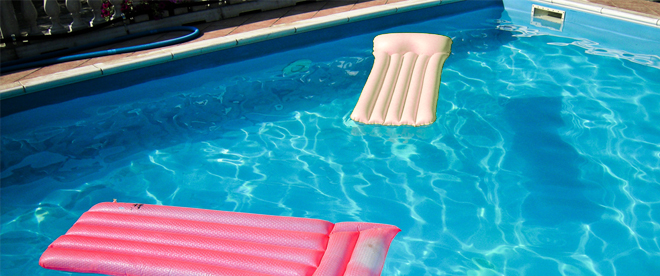When the days cool in early fall, pool owners know it is the end of the swimming season and time to close your pool for the cold weather months. It is a bittersweet time, but closing the pool the right way now means an easy opening just as soon as the warm weather comes rushing back.
Steps to Close a Pool
- Pool manufacturers and maintenance companies suggest the best time to close your pool is when the daytime temperatures in your area start dipping into the low 60s to 70s. Nighttime temperatures are much cooler and drop into the forties. In most climates, this occurs in mid-October. Lower water temperature lessens demand for chlorine. This means chlorine treatment last longer and should last over the winter. But, if you close your pool too soon, the chemicals you added for winter protection will be depleted before early spring. You are at risk for algae growth.
- Walk around the pool and do a visual inspection. Pay attention to the pool structure and be sure all equipment is in proper working order. Professionals at the Association of Pool and Spa Professionals strongly urge that structural defects and/or broken and worn out equipment be repaired before you close your pool. This will prevent further damage from happening and help to avoid problems when you open the pool when swimming season begins again.
- One week before you close the pool, check your pool chemical levels. Do this three to seven days before closing. If the chemicals are out of balance, adjust them. When a pool winters with out-of-balance chemicals the surface of the pool can corrode and scale builds up. Following are the proper chemical levels in a pool closed for the winter:
- pH: 7.2 – 7.6
- Alkalinity: 80 – 120 ppm
- Calcium Hardness: 175 – 250 ppm
- Chlorine: 1 – 3 ppm
Add winterizing chemicals carefully following the manufacturer’s instructions. The general methodology is to mix any granular type winter chemicals in a bucket in order to make sure they are completely dissolved before pouring them into the pool. When granular chemicals are not completely dissolved, they settle on the floor of your pool and leave unsightly chemical stains. After pouring the chemicals into the pool, circulate the water so the chemicals are fully dispersed.
Follow the pool manufacturer’s recommendations for draining the pool to the correct level. Be sure to drain water from the pump so that the level is one to one and one-half feet below the return lines. Doing this allows any water in the lines to drain into the pool so that the pipes do not freeze and become damaged. When all the water had drained out, plug the skimmer and jet holes so water does not get back into the lines.
Turn all equipment off. Make sure timers are off. Running equipment when the water level is lower than the jets can damage the pump.
Throughout the off-season, make inspections. Inclement weather can cause the water level in the pool to get to high and put pressure on the pool cover. If this happens, use a pool cover pump to remove excess water. This prevents the cover from stretching and sinking. If the cover has any debris, especially heavy objects such as a tree limb, remove it. Check that the chemicals you used to winterize the pool are working. Consider adding a couple of gallons of liquid shock half way through the winter.
Use a pool cover that is the proper one for your pool. Edges should be tightly sealed so that wind does not get under the cover lifting it and allowing leaves and other debris to get into the pool. For above ground pools consider the rugged affordable top of the line “Gorilla” winter cover. It has a 25 year guarantee. You might also consider the 20 year Armor Kote Above Ground Swimming Pool Cover.
Contact Us for Help and Supplies
Both can be bought from Family Pool Fun. where you can also find inground pool covers, pool tools and a complete line of chemicals. The friendly staff cheerfully answers any questions regarding pool maintenance. Call them at 1-800-950-2210

